Motorola Droid X: Thoroughly Reviewed
by Brian Klug on July 20, 2010 4:27 PM EST- Posted in
- Smartphones
- Motorola Droid X
- OMAP
- Mobile
Swype Keyboard
It isn’t enabled by default, but comes preloaded. I think it arguably is one of the largest steps forward in virtual keyboard interaction paradigms since the first iPhone’s usable virtual keyboard, perhaps since graffiti in Palm OS. Anyone remember those single stroke gestures? I had them down so pat back in the day I could nearly crank 30-40 WPM.
Regardless, Swype itself is a different and somewhat mind-bending way of inputting text. Instead of tapping and having the touch-up stroke denote a keypress, Swype works based on continual smooth swipes across the keyboard, with sharp changes in direction and a few other gestures denoting the characters that create a given word. You don’t input the entire word character by character, but swipe over the characters that form the word. Swype does some math behind the scenes, decides what word you likely meant based on those characters you passed, and pops out a word.
It’s mindbending because you run your finger across the keyboard instead of tapping. It’s even more of a twist because you might have to relearn the QWERTY layout a bit - I felt my mind CPU use go to 100% the first few words I tried. With a few days of practice, I was screaming along. The only side effect is that typing on a normal keyboard now feels odd; the first time I went back to my keyboard I found myself wanting to swype.
|
Left: Default installed keyboards, Middle: Typing "just," Right: Attempting to type "dood"
|
||
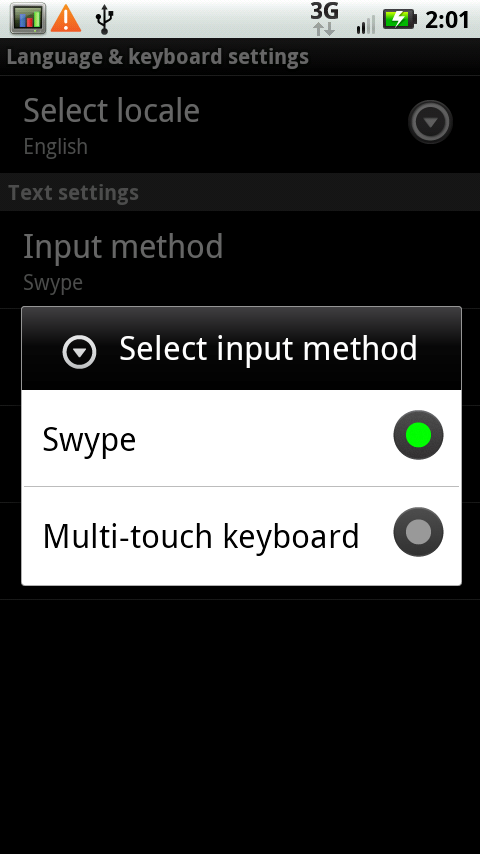 |
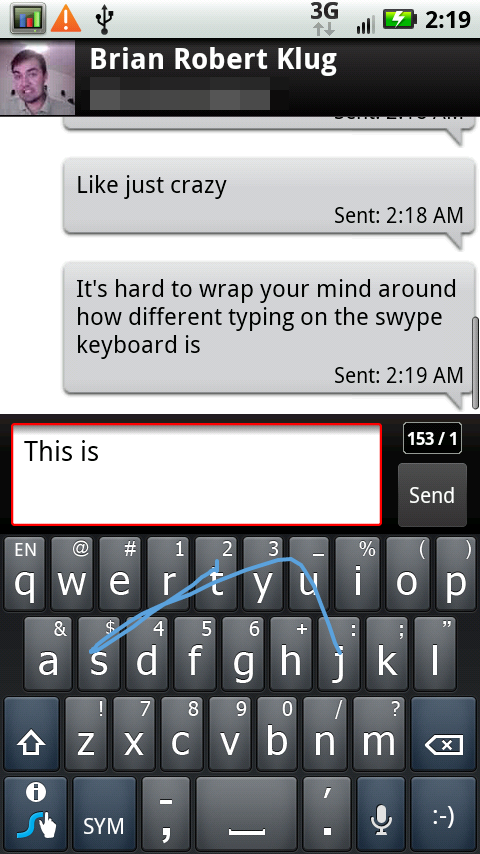 |
 |
Most of it is straightfoward - trace out what characters make up the word - but there are a few other things you need to do for special cases. For words with a character that repeats immediately, like “hello,” you make a circle over the character. For capitalization, swipe off the top of the keyboard and then back down.
If Swype doesn’t know the word you’re trying to input, or there are multiple possible words that could be formed with the keys you’ve passed over, it’ll pop up a box and prompt you to select which one you meant.
Of course, you don’t necessarily have to always use the swype gestures on their keyboard - you can tap and press just like a normal keyboard. In fact, for words that swype doesn’t know, this is how you teach it.
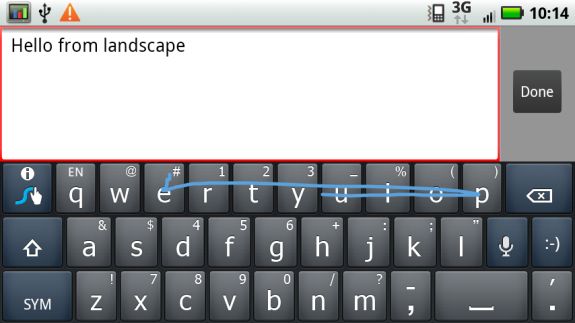 |
||
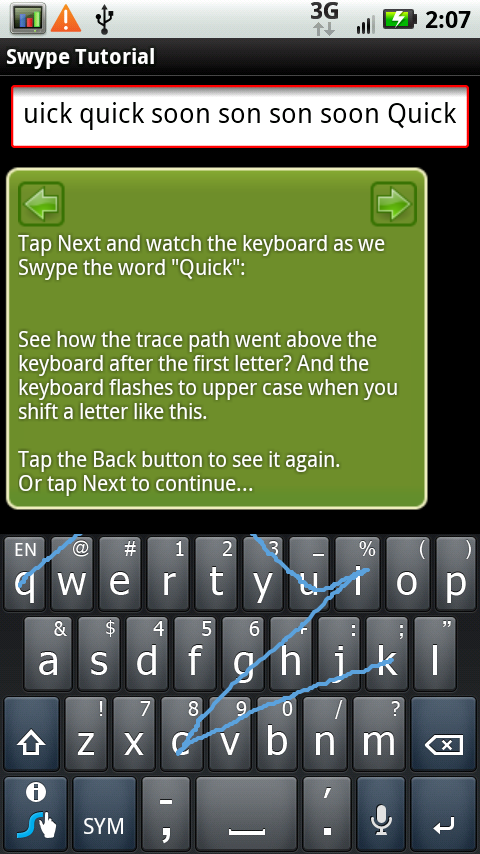 |
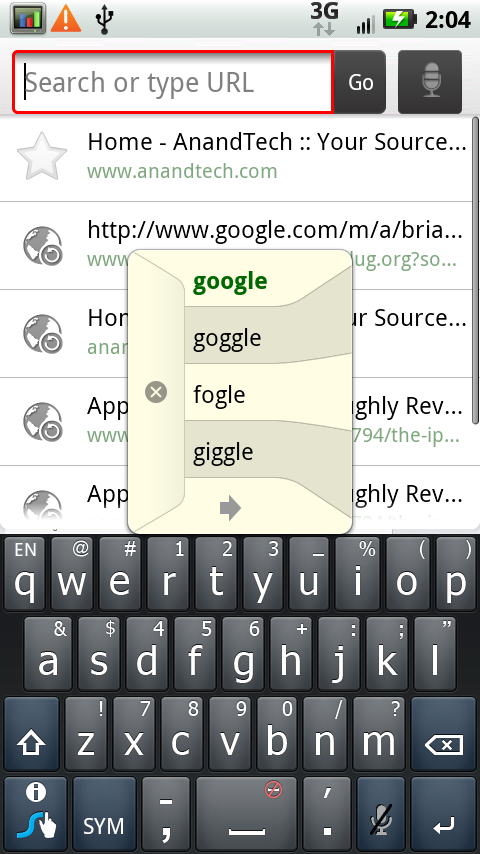 |
|
I can understand why Swype is shipped with the X disabled, but it’s such a great and different input method that I’m honestly left wondering why Google doesn’t acquire and license it across the entire platform. Sure, it takes some time to learn, but the Swype tutorial is excellent - I went from no knowledge to swyping away in under 10 minutes. That's much easier than the learning curve graffitti threw at users, for example.
The stock Android keyboard is completely depressing. In fact, it’s pretty much the one thing left on Android on the platform which makes me wince. The X’s excellent Blur multitouch keyboard and even better swype input methods more than mitigate the mammoth device lacking a hardware keyboard. The sheer size of the screen is what really makes it easy to type.










89 Comments
View All Comments
TareX - Thursday, July 22, 2010 - link
Why are all the Samsung Galaxy S phones missing from your charts and comparisons? I wanted to see how Hummingbird compared and how the Super AMOLED fared against their Droid X counterparts...strikeback03 - Tuesday, July 27, 2010 - link
Maybe because the first US version launched a day before the review went up, and they weren't sent a review sample.enealDC - Thursday, July 22, 2010 - link
Great job!Juniper Research - Friday, July 23, 2010 - link
Very interesting article... we have this week published a new report on smartphones and a free whitepaper is available to download here... http://www.juniperresearch.com/reports/next_genera...John Levett
Marketing Executive at Juniper Research
Homefries - Saturday, July 24, 2010 - link
First off, great review Brian.However, while you did a very thorough comparison of the Droid X to other Android devices, you barely mentioned the real competitor the Droid X has to stand up against: the iPhone 4.
Readers want to know if the Droid X is the best phone on the market - the whole market - not just the market subset dedicated to Android devices.
Like the majority of the tech media, your review furthers the notion readers belong exclusively to either the iOS camp or the Andriod camp. This is simply not true. Informed readers, like the ones that peruse Anandtech, want to buy one smartphone, regardless of any marketing slants, that is the best.
Your review of the Droid X should have helped us answer the question, "Should I buy the Droid X or the iPhone 4?" But, it did not.
strikeback03 - Tuesday, July 27, 2010 - link
Well, I think the conclusion in the iPhone article and some earlier Android articles applies, there is no "best" for everyone. Some people love Apple and the Apple way of life, some people won't touch it. As the iPhone is currently limited to AT&T, that is going to deter a lot of people. How large a pocket/bag you plan on carrying the phone in might make size differences more important to some than others. So while I am not one of the readers calling for no subjective opinions (it is interesting that FroYo feels significantly faster/different) I think it is still up to each buyer to decide what is most important to them.Electrofreak - Saturday, July 24, 2010 - link
Brian and Anand, are you sure you're using the correct information regarding the SoC in the Droid X? I believe it is a OMAP 3640, not a 3630, as the maximum recommended clock speed of the 3630 is described in numerous places across the net as being 720 MHz, while the max clock speed of the 3640 is described as 1 GHz. In addition, the max recommended clock speed of the 3430 in the Droid was 600 MHz, not 800.The information I cite above is widely available across the web... if you've got inside information the rest of us don't have, by all means let us know. But as someone who has written articles of my own on ARM SoCs and follows ARM industry news closely, I suspect that your data may not be 100% correct.
Regardless, I do have to thank you for writing some of the most informative hardware articles on the net. I appreciate it!
Electrofreak - Saturday, July 24, 2010 - link
...and I just found this: http://e2e.ti.com/blogs_/b/mobile_momentum/archive...So, per TI's blog it is the 3630... now we just need an explanation of the other info on the web that describes the 3630 as maxing out at 720 MHz.
Brian Klug - Monday, July 26, 2010 - link
Yeah, TI's documentation is a bit outdated. Anand tackled the SoC part, but the 3630 is indeed a 1 GHz part, it isn't the 3640 guaranteed. There was a lot of confusion online about it, but Anand got the official word. ;)I agree, back when I did my other OMAP 3 piece it was 720 MHz.
-Brian
Electrofreak - Saturday, July 24, 2010 - link
Looking forward to that Hummingbird review Brian. I hope you're able to dig up some info that I wasn't able to when I wrote my article (http://alienbabeltech.com/main/?p=17125) back in April.